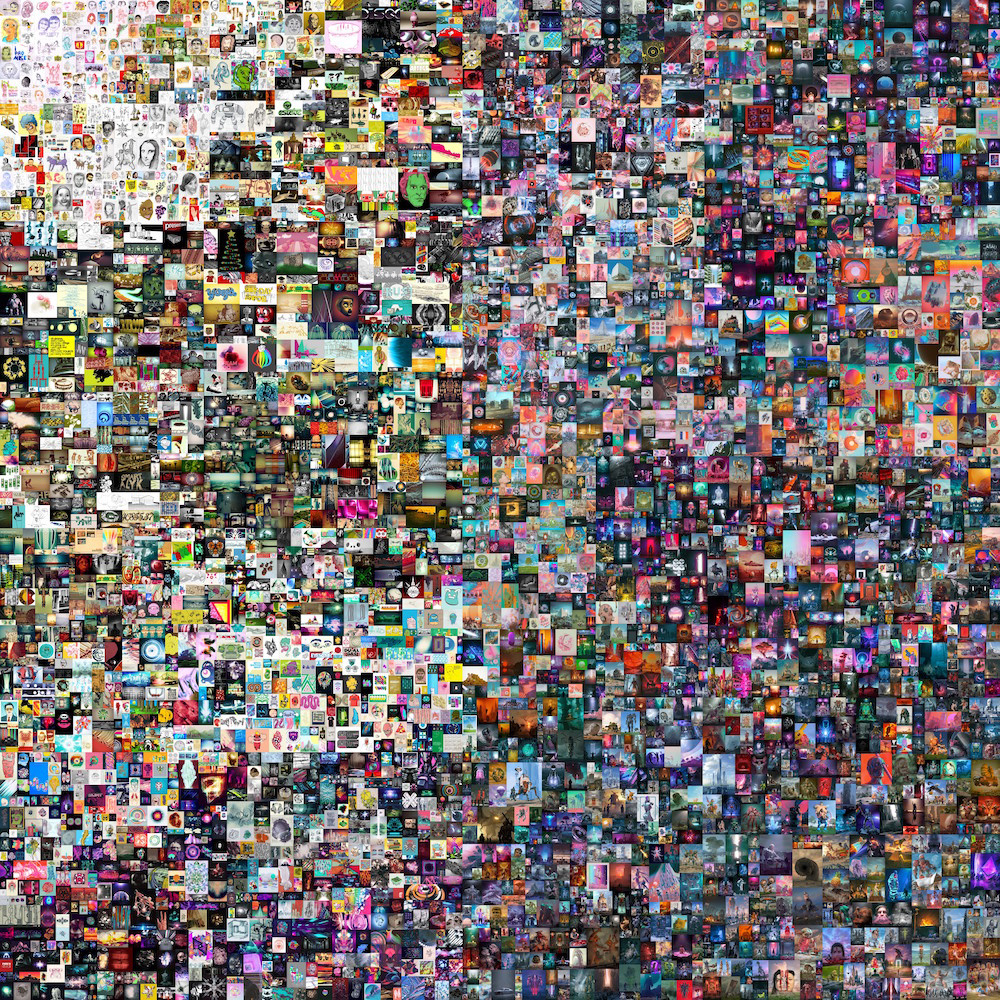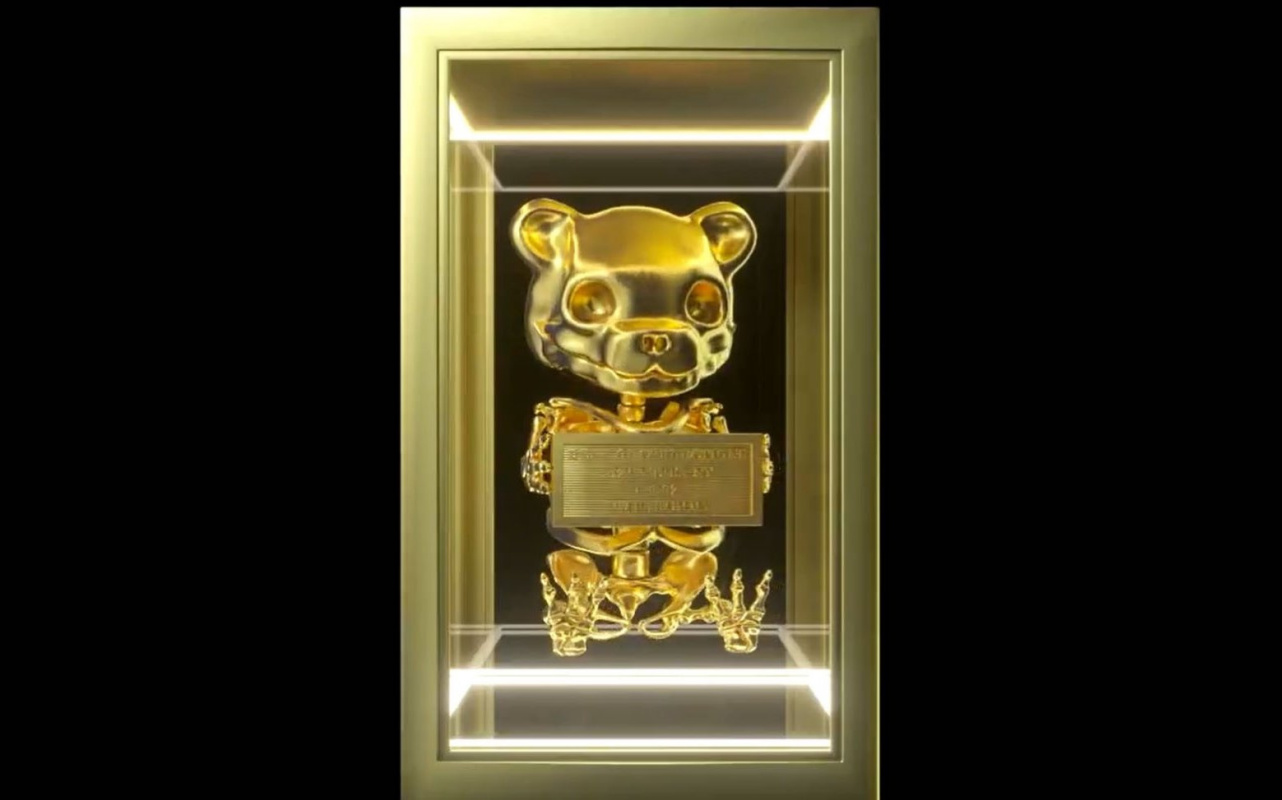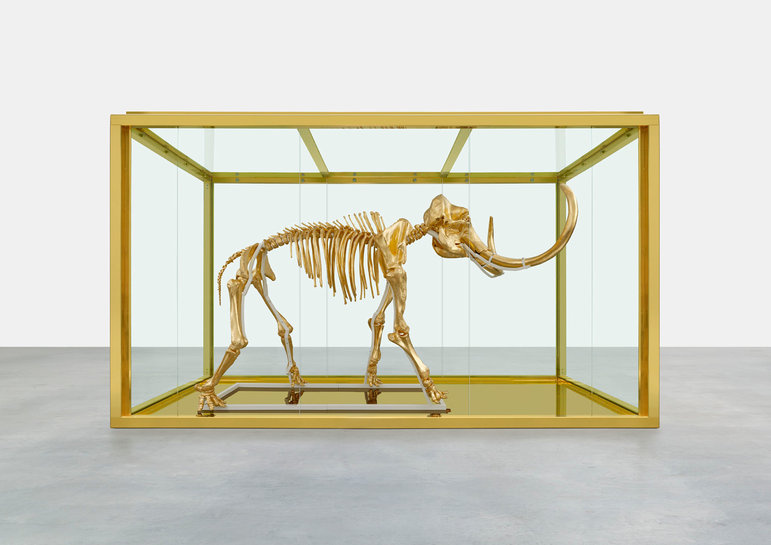The world has changed. On 11 March 2021, the art market was amazed by the news that a major auction house was selling a digital artwork for a record amount of $ 69.3 million. It’s all about the format: non-fungible tokens are unique markers. Thanks to new technology, digital works of all kinds, such as images, videos, and even social media posts, can now be proven to be original and passed from hand to hand. Unsurprisingly, the art market is buzzing with a new way to prove the exclusivity of a work of art. Let’s make it clear what these NFTs are and how they differ from ordinary tokens, what are the benefits of blockchain art, and where tokenized works can be purchased.

The iconic work was the collage
of five thousand drawings, Everydays: the First 5000 Days, which Winkelmann, aka Beeple, has been creating every day since 2007.
What are non-fungible tokens?
In short, tokens are units of blockchain assets.Whoa, what is blockchain?
This is the opposite of our good friend, the Internet connection system through providers, when computers only interact through intermediaries (such a network is called decentralized).
Blockchain is a kind of digital "hostel": a distributed network where all computers are connected to each other and constantly store all the necessary data. In fact, a blockchain is a chain of blocks with information encrypted with a code, where each new data operation (transaction) is written into a new block. At the same time, the information stored in them cannot be deleted or changed.
The blockchain idea was described back in the 20th century, but it was not until 2009 that it found application. An anonymous person known as Satoshi Nakamoto proposed the concept of the Bitcoin payment system, which was based on the blockchain. The programmers who tested the system discovered many advantages in it, and it soon spread throughout the world.

Blockchain visualization
In the world of this payment system, cryptocurrency works, electronic money or "coins" that do not physically exist. Their accounting is carried out using code in the same blockchain, which is also called an electronic register.
With the help of specialized services, coin holders can transfer coins to other people who have cryptocurrency wallets — mobile applications, computer programs or special flash drives for performing transactions with digital money.
The successful implementation of Bitcoin has pushed many programmers to develop similar blockchain-based platforms, the most disruptive of which is Ethereum. This system’s feature is that it is quite easy to program, which means that everyone can experiment with its code, develop applications based on it, and create their own assets.
These assets are called tokens, they can be stored and transferred in the same way as the cryptocurrency of the platform itself called ether.
Tokens can be compared to metro tokens, which are bought for money, and which can be used for their intended purpose or exchanged for other tokens of the same type. Only people who really need them will be able to sell them.
With the help of specialized services, coin holders can transfer coins to other people who have cryptocurrency wallets — mobile applications, computer programs or special flash drives for performing transactions with digital money.
The successful implementation of Bitcoin has pushed many programmers to develop similar blockchain-based platforms, the most disruptive of which is Ethereum. This system’s feature is that it is quite easy to program, which means that everyone can experiment with its code, develop applications based on it, and create their own assets.
These assets are called tokens, they can be stored and transferred in the same way as the cryptocurrency of the platform itself called ether.
Tokens can be compared to metro tokens, which are bought for money, and which can be used for their intended purpose or exchanged for other tokens of the same type. Only people who really need them will be able to sell them.

Work by NFT artist Pak, sold at Sotheby’s in conjunction with the Nifty Gateway marketplace for $ 1.4 million. The name of the work, The Switch, means that the NFT holder can irreversibly "switch" a work of art into another one, but no one knows what it will be.
The tokens we are talking about now are fungible tokens, but there are also non-fungible tokens or NFTs. What does it mean?
We can call a thing non-fungible, if it is formally cannot be replaced with the same one. For example, items released in large quantities, but then endowed with original properties: a used notebook, an autographed book, etc. We also consider something unique, if it is created in a singular or limited number: a painting, a limited collection of perfumes or a handmade postcard.
In the digital environment, cryptocurrency or ordinary tokens are interchangeable: one bitcoin is no different from another, just like two shares of the same company.
On the other hand, NFT is a unique token that is assigned to a specific image/audio/video/text/game asset or web address and gives it the exclusivity status.
Within the Etherium blockchain platform, there are standards, rules for creating tokens, which makes it possible for them to interact, move from platform to platform and consequently enables the existence of a global NFT market.
In general, a non-fungible token can be thought of as a password-protected link to a digital file included in the blockchain and owned by a specific person.
We can call a thing non-fungible, if it is formally cannot be replaced with the same one. For example, items released in large quantities, but then endowed with original properties: a used notebook, an autographed book, etc. We also consider something unique, if it is created in a singular or limited number: a painting, a limited collection of perfumes or a handmade postcard.
In the digital environment, cryptocurrency or ordinary tokens are interchangeable: one bitcoin is no different from another, just like two shares of the same company.
On the other hand, NFT is a unique token that is assigned to a specific image/audio/video/text/game asset or web address and gives it the exclusivity status.
Within the Etherium blockchain platform, there are standards, rules for creating tokens, which makes it possible for them to interact, move from platform to platform and consequently enables the existence of a global NFT market.
In general, a non-fungible token can be thought of as a password-protected link to a digital file included in the blockchain and owned by a specific person.

Visualization of an NFT linked to a media file
Why are NFTs relevant?
For artists who link their artwork to non-fungible tokens, their properties are of great value and a bunch of new possibilities.It enables every artist: может:
- to prove his authorship;
- to determine its uniqueness: a file can exist in one instance, or it can have several copies, each of which is linked to its own token. However, the price of such replicas is lower than that of a unique NFT — it can be compared to a limited edition of engravings;
- to sell their product on any marketplace or directly;
- to receive royalties from each subsequent resale of their work, if this is provided for in the code of the linked NFT.
These benefits are most relevant to digital artists, as before the invention of tokens, it was nearly impossible to confirm the authenticity of their creations, such as paintings, drawings, animations, videos, or even music tracks. A copy did not differ from original picture, which means that its value was not supported by anything.
Duplication of works linked to NFTs only benefits them, because their popularity grows in this way, which means that the price of the original work increases; the original work cannot be faked thanks to tokenization (as it was believed until recently).
Duplication of works linked to NFTs only benefits them, because their popularity grows in this way, which means that the price of the original work increases; the original work cannot be faked thanks to tokenization (as it was believed until recently).

An animation by NFT artist Misha Dovbak (aka Mad Dog Jones) titled Replicator, sold by Phillips auction house for $ 4.1 million. Every 28 days it generates unique NFTs, each with a different value. As a result, there will be 180 to 220 non-fungible tokens.
Are real well-known artworks linked with tokens?
"They've already evaluated the didgital Mona Lisa!" exclaim web news. Well, physical assets (for example, paintings and sculptures), or rather, their ownership rights, can also be tokenized.Although at the moment there are already projects dedicated to the tokenization of real items, the legislative framework has not yet been created for these processes, which means that the acquisition of such things involves some risks. However, auction platforms such as Maecenas successfully sell works by Picasso, Rubens, Matisse, Warhol and other great artists, creating NFT certificates of ownership for their paintings.

Andy Warhol’s 14 Small Electric Chairs collage
(silk-screen printing on canvas), sold by the Maecenas auction platform for $ 6.5 million to a hundred people at once for fractional ownership.
NFTs are beneficial not only for artists, but also for art buyers. Holders of tokenized assets can:
- prove that the work is their property, as this information is recorded in the blockchain;
- sell the work and make money on it if its price is risen (in some cases, artists get their fee after each purchase);
- leave the file in their collection and store it in their wallet, as well as, if they wish, demonstrate it on special sites, which we will talk about a little later.
Besides, tokenization can have a positive impact on the general art market. So, some experts argue that it makes the art market more democratic.
Cons of tokenization
The most significant drawback of NFT art is the lack of a legislative framework that would regulate copyright issues, preventing theft and counterfeiting of other people’s works, which is happening more and more often in the wake of the tokenization popularity. At the same time, at the moment, only marketplaces moderators are struggling with such situations.The NFT market also needs law that would help prevent the disappearance of already purchased files from the wallets of their owners — there have been many complaints about such incidents in recent months from users of various platforms selling digital art. In most cases, the blockchain code is associated to the URL of the work, which means that if something happens to the site hosting it, or the image (video/audio) is removed from it, then the person who purchased the work also loses their access.

The work of an anonymous artist Pak, The Pixel, is literally a grey pixel that represents the emergence of digital art in traditional auction houses. The image was sold at Sotheby’s in conjunction with the Nifty Gateway marketplace for $ 1.355555 million.
Of course, there are file systems such as IPFS — uploaded works cannot be completely destroyed on them, but they are not used by all artists. In addition, the disappearance (or lack of display) of the purchased work may also be caused by a violation of the terms of service of the marketplace or an unusual token format. There are many such problems, and all of them are associated with the use of unreliable third-party applications and sites, which are often indispensable when purchasing tokenized art.
It is no surprise that experts disagree about the future of the industry: some of them do not doubt the potential of the blockchain, the upcoming qualitative changes in the sector and its further growth, while others are confident in the short lifetime of the increased demand for NFT.
It is no surprise that experts disagree about the future of the industry: some of them do not doubt the potential of the blockchain, the upcoming qualitative changes in the sector and its further growth, while others are confident in the short lifetime of the increased demand for NFT.

Kevin McCoy’s Quantum was the first "minted" NFT, released back in 2014. The animation entirely created with code can change its shape to a self-generated one. The final cost of the work on the SuperRare platform was $ 1.4 million.
How to apply this knowledge?
If you are an artist who creates in the digital space, or an art lover seeking to purchase tokenized work, then you should start a cryptocurrency wallet and register on one of the platforms that sell NFT works.Advanced users recommend to start with MetaMask or another wallet that supports the ERC-721 standard (that is, the Ethereum-based standard for unique tokens).
The easiest way to list and purchase NFT art is through marketplaces that are a kind of combination of auction houses, galleries and release protocols (which means you can tokenize your art directly on the platforms). Among the most popular are OpenSea, Rarible and Mintable, as well as Async Art, Nifty Gateway, KnownOrigin, SuperRare, MakersPlace, Foundation, Portion, Mintbase, and Zora. Note that each of the sites has its own characteristics and philosophy, which should be taken into account when choosing a place for the sale and purchase of works.

Ocean Front by Beeple warns of the dangers of climate change. The artist promised to donate the $ 6 million raised from the sale of the work on the Nifty Gateway site to the Open Earth Foundation.
What can you do with the NFT art you’ve purchased?
You might try to resell it for a greater price or keep it for yourself — in this case, you have several options:- if you want to demonstrate tokenized works in a physical environment, you need special digital frames (or, alternatively, you can make them wallpaper on your computer or smartphone);
- some marketplaces allow their users not only to buy works, but also to create their collections that are visible to others;
- and there are also virtual worlds and metauniverses, in which you can create your own museums and galleries, such as Decentraland, TerraVirtua and Cryptovoxels (the latter platform is focused specifically on art).
No matter how you decide to dispose of your purchase — in the virtual space, you have almost the same choice as in the real world.

Paris Hilton not only supports the foundation that provides grants to cryptoartists, but also creates NFT in collaboration with Blake Catherine. One of their collaborations (Virtual) blondes have more fun, right? was sold at the Nifty Gateway marketplace for $ 1.111211 million.
Why did NFT art sound like that right now?
Today’s fascination with NFT, according to experts, is the result of several factors, including the unprecedented interest in digital assets due to the global transition to the Internet during the pandemic, as well as the active state of financial markets in general and increasing prices for cryptocurrency in particular. If we specifically talk about the art field, one can add another reason: while live auctions and real museums were banned during lockdowns, online marketplaces became an excellent option for bidding, and online galleries in the metaverse became an opportunity to admire art from the comfort of your home.In his comment on Fox News Sunday, artist Beeple, the one whose non-fungible painting token was sold for the record $ 69.3 million, likened the NFT market to a bubble and drew a parallel to the early days of the Internet. "It also was a time of a ‘bubble' and it burst. But this did not destroy the Internet. It is the same with NFT tokens, this is a rather strong technology and I think it will survive," he said. Well, right now we are witnessing the very first "boom" associated with the revolutionary technology popularization.

The EverLasting Beautiful of a 18-year-old artist FEWOCiOUS was sold for $ 550 thousand on the Nifty Gateway marketplace. FEWOCiOUS began his art career at the age of 13, and a month ago five of his works were sold at Christie’s for a total of $ 2.1 million.
Sources: Wikipedia, Medium, Euronews, Bitcoin.org, Bitcoinwiki, Fortrader.org, Moneon, Currency.com, Binance Academy, Ethereum.org, Forclog, tproger.com, OpenSea, linda.mirror.xyz, Maecenas, Tokend, artnet, BeInCrypto, Vice, DFT Magazine, vc.ru, Maff, justincone.com
Image sources: artnet, blog.maecenas.co, techsmartest.com, justincone.com
Image sources: artnet, blog.maecenas.co, techsmartest.com, justincone.com










